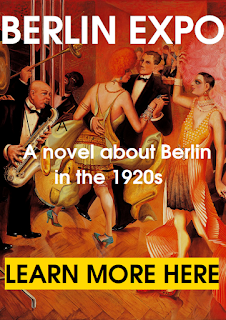Weimar Germany, a book
University of Minnesota history professor Eric D. Weitz has written a book about Weimar Germany. He sees that era as a time of progressive achievements and he views Weimar in its own right, not just as a prelude to the Third Reich.Link to professor Weitz' book on Amazon
One of the chapters
is devoted to Berlin, the capital of the Weimar Republic.
Here, a excerpt from
that chapter :
Weimar was Berlin,
Berlin Weimar. With more than four million residents,
the capital was by far the largest city in Germany, the second largest
in Europe, a megalopolis that charmed and fright-
ened, attracted and
repelled Germans and foreigners alike.
In the 1920s it was one of
Germany’s and Europe’s great cultural centers, the home of the
Philharmonie, the State Opera, the Comic Opera, scores of theaters,
and a cluster of great museums, all located in the center of the city.
Berlin was a magnet for artists and poets, the young and ambitious. It
had a glittering nightclub scene, including scores of homosexual bars, and
a relentless fascination with the body and sex.
Berlin was a great
economic machine that churned out electrical goods, textiles, and
confectionary products in huge quantities. It was the governmental
center, and from the famed Wilhelmstraße, home of the Foreign
Office, the Reich Chancellery, where the government sat, and the
Reichstag, the parliament building, Germany’s leaders and bureaucrats
tried desperately to maintain order, promote prosperity, and revive
the nation’s international position.
It was a city of leisure, with
neighborhoods of elegant wealth and amusement parks, a zoo, and numerous
lakes accessible by rail or streetcar to virtually all Berliners. Its
infamous tenement blocks rivaled the slums of any great city for their
darkness, congestion, and poverty. Tens of thousands of Russian
émigrés, fleeing from communism, and Poles looking for work and
business opportunities contributed to the city’s international feel.
Berlin’s Jewish community was the largest in Germany, its main
synagogue an elegant symbol of piety and prosperity. The Berlin
Dom, the Protestant cathedral commissioned by Kaiser Wilhelm II
and completed in 1905, had a massive presence, its bombastic, late
Renaissance style a testament to the pretensions and arrogance of the
Hohenzollern rulers deposed in the revolution of 1918–19.
 |

No comments:
Post a Comment